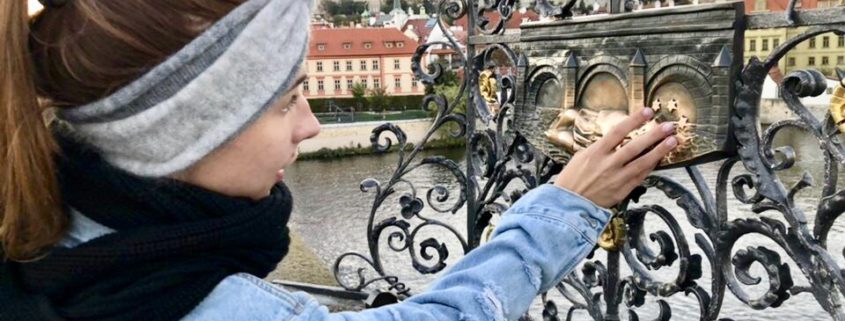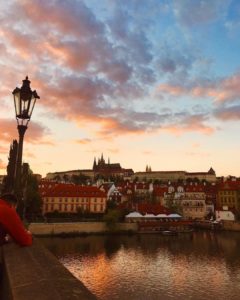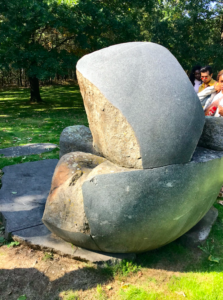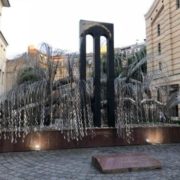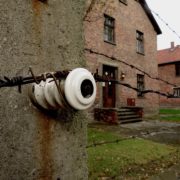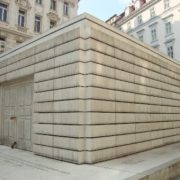Painful Prague
By Kristen Varganova
Although all the countries we visited throughout our first two weeks of travel were exceptionally beautiful and filled with unique history; the city that resonated most with me was Prague. From the delicate architecture to the painful stories of the Czech-Roma, Prague was the hardest goodbye yet.
As soon as we got off the bus in the Czech Republic we were welcomed by ruby red roof tops and Zed, our enthusiastic tour guide. Zed took us on a four-hour tour where we learned about the history of Czechoslovakia and the effects the Nazi-Germany had on this region.
Half-way through our tour we found ourselves walking across the Charles Bridge. Charles Bridge was originally known as the Stone Bridge because it was the only bridge in Prague. There, Zed pointed out a statue of a man with five stars in the shape of a halo fixated above his head. Zed explained that the statue represents Saint John of Nepomuk, a priest to the former King Wenceslas IV. Legend has it that the King suspected his Queen of cheating on him, so he asked the Priest to tell him about her confession. Saint John of Nepomuk refused to reveal the Queen’s confession for which he paid for with his life. Many believe that the King killed Saint John of Nepomuk in 1383, cut off his tongue and threw his body into the Vltava river.
However, Zed explained that this legend is a tourist hoax. The real reason for why the King executed Saint John of Nepomuk was because he invited a bishop to Prague who was known to be the King’s enemy.
A few steps left of the statue is the place where the Saint was thrown in the river. To commemorate his death a plaque of a cross and five stars was raised. Many believe that if you touch the cross with your left hand and the stars with your right while making a wish, whatever you wished for will come true.
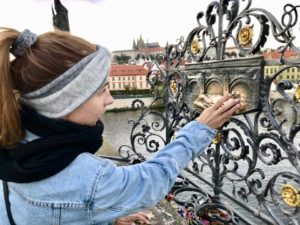
Legend has it that if you touch the five stars on the Charles Bridge plaque and make a wish, whatever you wished for will come true!
I was amazed at how much history was captivated in one place. Living in the United States the only place that can come close to holding so much meaning behind it is Washington D.C or Boston, Massachusetts. As the rest of the group moved forward I stayed back and made a wish while touching the plaque of stars.
The following day we attended the library of Roma-futurism. There, Vladislava talked about how the library came to be and the general background of the Czech-Roma people. It was shocking to hear that the Roma kids attend segregated schools to this day. As we walked around the library at the end of Vladislava’s speech, I couldn’t help but notice Russian books scattered among the shelves. It was really interesting to see a little bit of my past and my roots among the Romani literature.
As our last day winded down to an end we took a short bus ride over to Lety, a former concentration camp built specifically for the Romani people. I was shocked to find out that this concentration camp was set up by the Czechoslovak government. Krista, our tour guide for the day, explained that two weeks before the German occupation the Czechoslovak government set up this labor camp in hopes of putting the Roma to work. This made me think back to the theme of puppet regimes that has been prominent throughout all of our previous visits.
At Lety I couldn’t help but notice the contrast between life and death. The monument commemorating those fallen at the concentration camp was surrounded by a forest and blooming trees. I found it almost ironic that such a painful monument was placed among such a beautiful and alive land.
Growing up I have never heard the term “Roma.” I was always taught that these people were known as cigans, a word that almost seemed derogatory but somehow was okay to use. When I moved to the United States I was finally introduced to the word “Roma.” It was very interesting to see that in Central Europe people refer to the Romani by using various terms such as gypsies and cigans. Although I found a small connection between my Russian upbringing and the linguistics of Central Europe, the overall dislike of the Soviet Union and present day Russia is prominent in every country that we have visited.
All in all, Czech history is filled with painful memories. From the execution at the Charles bridge to the prejudice attitudes against the Romani population, the former region of Czechoslovakia has a deep and conflicting narrative. However, the present day Czech society is hopeful and eager to come to terms with it’s painful past.

